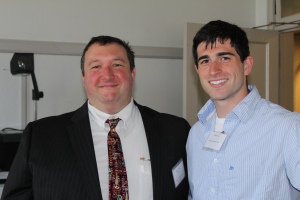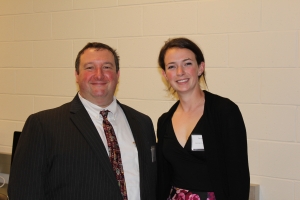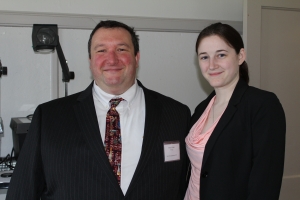Samantha Chevalier
Arrestin Dependent Activation of ERK1/2 in Response to Follicle Stimulating Hormone
 The human follicle stimulating hormone (hFSH) is a member of the glycoprotein hormone receptor family involved in regulating gametogenesis. When hFSH binds to its receptor it triggers the production of cAMP via adenylate cyclase and causes the activation of MAP kinases like p38 and ERK1/2. The goal of these experiments was to determine if MAP kinase activation was dependent on cAMP activation of protein kinase A. To characterize the role of PKA we used the inhibitor H89 and then investigated p38 and ERK1/2 activation in response to FSH. No effect was seen from H89 on p38 and ERK1/2 activation. In other labs, beta-arrestin has been implicated as a potential activator of ERK1/2. To determine the role of beta-arrestin in FSH induced MAP kinase activation we used short hairpin RNA (shRNA) to knockdown beta-arrestin 1 and 2. When beta-arrestin was knocked down ERK ½ activation was decreased and activation of p38 was unchanged. This suggests that there are two different activation pathways for p38 and p44/42. Understanding the mechanism of activation of the MAP kinases could lead to future advances in contraception or therapies for improvement of fertility.
The human follicle stimulating hormone (hFSH) is a member of the glycoprotein hormone receptor family involved in regulating gametogenesis. When hFSH binds to its receptor it triggers the production of cAMP via adenylate cyclase and causes the activation of MAP kinases like p38 and ERK1/2. The goal of these experiments was to determine if MAP kinase activation was dependent on cAMP activation of protein kinase A. To characterize the role of PKA we used the inhibitor H89 and then investigated p38 and ERK1/2 activation in response to FSH. No effect was seen from H89 on p38 and ERK1/2 activation. In other labs, beta-arrestin has been implicated as a potential activator of ERK1/2. To determine the role of beta-arrestin in FSH induced MAP kinase activation we used short hairpin RNA (shRNA) to knockdown beta-arrestin 1 and 2. When beta-arrestin was knocked down ERK ½ activation was decreased and activation of p38 was unchanged. This suggests that there are two different activation pathways for p38 and p44/42. Understanding the mechanism of activation of the MAP kinases could lead to future advances in contraception or therapies for improvement of fertility.
Martin Cole
Mutation of the Caveolin Interaction Motif of the Human Follicle Stimulating Hormone Receptor
 Follicle Stimulating Hormone Receptor is a G-protein coupled receptor that localizes to rigid domains in the cell membrane known as caveolae. In the fourth transmembrane domain, there is a region of the receptor that contains a putative caveolin interaction motif (CIM) an alpha helix with 4 critical phenylalanine residues. These residues are critical to the localization of the receptor to caveolae. The goal of my research has been to mutate these phenylalanine residues to the amino acid leucine. Our hypothesis is that this conservative mutation will result in a mutant receptor that is no longer able to localize to the caveolae but still travels to the plasma membrane. Furthermore, if the receptors localize to other regions of the cell membrane, we hope to discover how this affects signaling. This would help demonstrate the necessity of receptor localization to caveolae for normal function. This would provide valuable information about signaling, and may help to create a novel way to inhibit FSH signaling by interrupting FSHR-caveolin interactions.
Follicle Stimulating Hormone Receptor is a G-protein coupled receptor that localizes to rigid domains in the cell membrane known as caveolae. In the fourth transmembrane domain, there is a region of the receptor that contains a putative caveolin interaction motif (CIM) an alpha helix with 4 critical phenylalanine residues. These residues are critical to the localization of the receptor to caveolae. The goal of my research has been to mutate these phenylalanine residues to the amino acid leucine. Our hypothesis is that this conservative mutation will result in a mutant receptor that is no longer able to localize to the caveolae but still travels to the plasma membrane. Furthermore, if the receptors localize to other regions of the cell membrane, we hope to discover how this affects signaling. This would help demonstrate the necessity of receptor localization to caveolae for normal function. This would provide valuable information about signaling, and may help to create a novel way to inhibit FSH signaling by interrupting FSHR-caveolin interactions.
Ayon Ibrahim
Isolating RNA aptamers targeting the human follicle stimulating hormone receptor
 Oral contraceptive pills use high doses of hormone to suppress the reproductive arm of the endocrine system in women. However, these drugs can have harmful long term side effects such as increased risk of stroke, heart attack, and breast cancer. Therefore, it has become an important public health goal to look for alternative ways of providing contraception. Aptamers, oligonucleotides that bind to specific molecules due to their unique 3-dimensional structure, are one alternative that has yet to be explored. The goal of our research is to develop an RNA aptamer that will bind selectively to the hFSHR. We first incubated a large pool containing random sequence oligonucleotides with wild type HEK293 cells (which do not have hFSHR) as a counter-selection. Many of the RNA molecules presumably bound to these cells. The unbound molecules were then incubated with HEK293 cells expressing the hFSHR. The oligonucleotides that bound were removed from the cells, isolated, and then re-amplified. The process of selection was repeated while increasing stringency of binding each time. This process is expected to yield a small number of aptamers that bind specifically to hFSHR. These aptamers will then be tested in vitro to determine their activity.
Oral contraceptive pills use high doses of hormone to suppress the reproductive arm of the endocrine system in women. However, these drugs can have harmful long term side effects such as increased risk of stroke, heart attack, and breast cancer. Therefore, it has become an important public health goal to look for alternative ways of providing contraception. Aptamers, oligonucleotides that bind to specific molecules due to their unique 3-dimensional structure, are one alternative that has yet to be explored. The goal of our research is to develop an RNA aptamer that will bind selectively to the hFSHR. We first incubated a large pool containing random sequence oligonucleotides with wild type HEK293 cells (which do not have hFSHR) as a counter-selection. Many of the RNA molecules presumably bound to these cells. The unbound molecules were then incubated with HEK293 cells expressing the hFSHR. The oligonucleotides that bound were removed from the cells, isolated, and then re-amplified. The process of selection was repeated while increasing stringency of binding each time. This process is expected to yield a small number of aptamers that bind specifically to hFSHR. These aptamers will then be tested in vitro to determine their activity.
Sarah Logan
Imaging Live Cells Using Atomic Force Microscopy and Confocal Microscopy
 A major component in both male and female reproductive endocrinology is follicle-stimulating hormone (FSH). Its receptor (hFSHR), necessary for normal human reproduction, is inserted in the membrane of Sertoli cells in males and granulosa cells in females. Preliminary work in this lab has suggested that hFSHR resides in specific parts of the cell membrane known as caveolae and is associated with the protein caveolin. The goal of this project is to use multiple microscopy techniques to visualize the location of caveolin and hFSHR on the cell membrane. The caveolin gene was fused to the gene for a red fluorescent protein to allow for visualization of the protein in confocal microscopy. Additionally, we utilized atomic force microscopy (AFM) to develop a topographical map of the membrane of cells expressing hFSHR. Future work will focus on overlaying the 2 images to determine where the proteins are located and if they are in close enough proximity to interact. In the future, these findings may have implications for reproductive endocrinology and the pharmaceutical approaches to help enhance or hinder hFSH performance in males and females.
A major component in both male and female reproductive endocrinology is follicle-stimulating hormone (FSH). Its receptor (hFSHR), necessary for normal human reproduction, is inserted in the membrane of Sertoli cells in males and granulosa cells in females. Preliminary work in this lab has suggested that hFSHR resides in specific parts of the cell membrane known as caveolae and is associated with the protein caveolin. The goal of this project is to use multiple microscopy techniques to visualize the location of caveolin and hFSHR on the cell membrane. The caveolin gene was fused to the gene for a red fluorescent protein to allow for visualization of the protein in confocal microscopy. Additionally, we utilized atomic force microscopy (AFM) to develop a topographical map of the membrane of cells expressing hFSHR. Future work will focus on overlaying the 2 images to determine where the proteins are located and if they are in close enough proximity to interact. In the future, these findings may have implications for reproductive endocrinology and the pharmaceutical approaches to help enhance or hinder hFSH performance in males and females.
Kaitlyn Staring
Comparison of Apoptotic Potential of Wild and Cultivated Extracts of Cordyceps sinensis
 Cordyceps sinensis is a mushroom which contains the compound cordycepin (3’-deoxyadenosine), an analogue of adenosine. In Traditional Chinese Medicine (TCM), cordycepin has multipurpose pharmacological uses including purported anti-tumor effects. In the present study, cordycepin was extracted from the wild mushroom as well as from various commercially available cultivated extracts. Previous research in this lab has demonstrated that cultivated extracts contain less cordycepin than the wild mushroom. However, it is unclear if the decrease in cordycepin correlates with decreased activity. To measure anti-tumor activity, extracts were used to treat mouse Leydig tumor cells (MA-10 cells). In other labs, cordycepin has been shown to induce apoptosis, or programmed cell death in MA-10 cells. Activity was evaluated using light microscopy to observe cell morphology and DNA electrophoresis to discern DNA laddering, both of which should be hallmarks of apoptosis. Using these methods the anticipated outcome is to determine if there is a dose and time dependent manner to the cordycepin-induced cell death as well as differential effects across the various cordycepin supplements which may contain other active compounds.
Cordyceps sinensis is a mushroom which contains the compound cordycepin (3’-deoxyadenosine), an analogue of adenosine. In Traditional Chinese Medicine (TCM), cordycepin has multipurpose pharmacological uses including purported anti-tumor effects. In the present study, cordycepin was extracted from the wild mushroom as well as from various commercially available cultivated extracts. Previous research in this lab has demonstrated that cultivated extracts contain less cordycepin than the wild mushroom. However, it is unclear if the decrease in cordycepin correlates with decreased activity. To measure anti-tumor activity, extracts were used to treat mouse Leydig tumor cells (MA-10 cells). In other labs, cordycepin has been shown to induce apoptosis, or programmed cell death in MA-10 cells. Activity was evaluated using light microscopy to observe cell morphology and DNA electrophoresis to discern DNA laddering, both of which should be hallmarks of apoptosis. Using these methods the anticipated outcome is to determine if there is a dose and time dependent manner to the cordycepin-induced cell death as well as differential effects across the various cordycepin supplements which may contain other active compounds.
Practicum students
- Tyler Barnhart ’14
- Megan Dondarski ’14
- Catherine Tjan ’14
- Jack Steinharter ’15
Honorary members
- Samantha Tyler ’14

You must be logged in to post a comment.